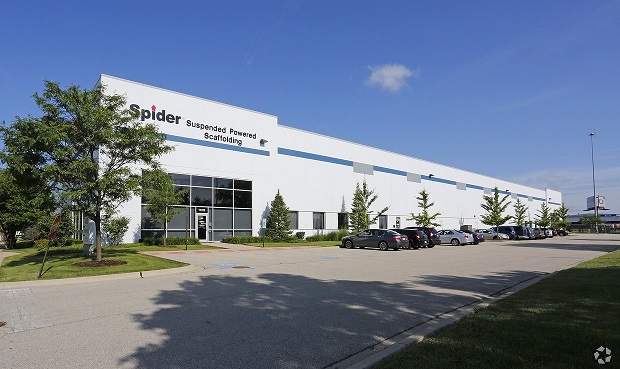 CHICAGO—The Chicago industrial market has gotten very tight, and landlords that have open spaces in modern buildings, especially ones geared toward distribution, have every reason to be confident that they can find willing tenants. But alongside all of this leasing activity, and the ongoing development meant to satisfy the demand, another portion of the market is definitely not favorable to landlords. According to the latest market report by Transwestern , “tenants in the 20,000 to 60,000 square foot range should expect favorable deals in the next few quarters.” “That type of space has been the slowest to get absorbed,” Ryan Phillips, a director at Transwestern, tells GlobeSt.com. “And once you get above 60,000 or 80,000 square feet the opportunities diminish.” The company's survey shows more than 800 properties in the metro area available for tenants that need the smaller size range. For the tenants looking for larger spaces, the alternatives drop to less 350 properties. And landlords seem willing to offer smaller tenants favorable deals and fill up existing buildings before they have to face competition from new construction. “Even if you are happy with the space you're in, you can still show your landlord that you have a lot of options and use that advantage to renegotiate your current lease,” says Phillips. It's true that few developers have targeted smaller tenants. Many have spent the last few years constructing buildings in the 100,000 to 200,000 square foot range, and when trying to lease these up, “everyone wants to hit a home run” by finding a full-building user, says Phillips. And that means many of the smaller spaces around the region are in older buildings that have 16' or even 12' ceiling heights. Still, among those 800 or so properties, Phillips believes there are a lot of decent small spaces, and once new product with better lighting, new technology, and higher ceilings hits the market, a disparity of rates will occur. In fact, new constructions will go for rates $1.00 to $2.00 higher than existing properties.
CHICAGO—The Chicago industrial market has gotten very tight, and landlords that have open spaces in modern buildings, especially ones geared toward distribution, have every reason to be confident that they can find willing tenants. But alongside all of this leasing activity, and the ongoing development meant to satisfy the demand, another portion of the market is definitely not favorable to landlords. According to the latest market report by Transwestern , “tenants in the 20,000 to 60,000 square foot range should expect favorable deals in the next few quarters.” “That type of space has been the slowest to get absorbed,” Ryan Phillips, a director at Transwestern, tells GlobeSt.com. “And once you get above 60,000 or 80,000 square feet the opportunities diminish.” The company's survey shows more than 800 properties in the metro area available for tenants that need the smaller size range. For the tenants looking for larger spaces, the alternatives drop to less 350 properties. And landlords seem willing to offer smaller tenants favorable deals and fill up existing buildings before they have to face competition from new construction. “Even if you are happy with the space you're in, you can still show your landlord that you have a lot of options and use that advantage to renegotiate your current lease,” says Phillips. It's true that few developers have targeted smaller tenants. Many have spent the last few years constructing buildings in the 100,000 to 200,000 square foot range, and when trying to lease these up, “everyone wants to hit a home run” by finding a full-building user, says Phillips. And that means many of the smaller spaces around the region are in older buildings that have 16' or even 12' ceiling heights. Still, among those 800 or so properties, Phillips believes there are a lot of decent small spaces, and once new product with better lighting, new technology, and higher ceilings hits the market, a disparity of rates will occur. In fact, new constructions will go for rates $1.00 to $2.00 higher than existing properties.  CHICAGO—The Chicago industrial market has gotten very tight, and landlords that have open spaces in modern buildings, especially ones geared toward distribution, have every reason to be confident that they can find willing tenants. But alongside all of this leasing activity, and the ongoing development meant to satisfy the demand, another portion of the market is definitely not favorable to landlords. According to the latest market report by Transwestern , “tenants in the 20,000 to 60,000 square foot range should expect favorable deals in the next few quarters.” “That type of space has been the slowest to get absorbed,” Ryan Phillips, a director at Transwestern, tells GlobeSt.com. “And once you get above 60,000 or 80,000 square feet the opportunities diminish.” The company's survey shows more than 800 properties in the metro area available for tenants that need the smaller size range. For the tenants looking for larger spaces, the alternatives drop to less 350 properties. And landlords seem willing to offer smaller tenants favorable deals and fill up existing buildings before they have to face competition from new construction. “Even if you are happy with the space you're in, you can still show your landlord that you have a lot of options and use that advantage to renegotiate your current lease,” says Phillips. It's true that few developers have targeted smaller tenants. Many have spent the last few years constructing buildings in the 100,000 to 200,000 square foot range, and when trying to lease these up, “everyone wants to hit a home run” by finding a full-building user, says Phillips. And that means many of the smaller spaces around the region are in older buildings that have 16' or even 12' ceiling heights. Still, among those 800 or so properties, Phillips believes there are a lot of decent small spaces, and once new product with better lighting, new technology, and higher ceilings hits the market, a disparity of rates will occur. In fact, new constructions will go for rates $1.00 to $2.00 higher than existing properties.
CHICAGO—The Chicago industrial market has gotten very tight, and landlords that have open spaces in modern buildings, especially ones geared toward distribution, have every reason to be confident that they can find willing tenants. But alongside all of this leasing activity, and the ongoing development meant to satisfy the demand, another portion of the market is definitely not favorable to landlords. According to the latest market report by Transwestern , “tenants in the 20,000 to 60,000 square foot range should expect favorable deals in the next few quarters.” “That type of space has been the slowest to get absorbed,” Ryan Phillips, a director at Transwestern, tells GlobeSt.com. “And once you get above 60,000 or 80,000 square feet the opportunities diminish.” The company's survey shows more than 800 properties in the metro area available for tenants that need the smaller size range. For the tenants looking for larger spaces, the alternatives drop to less 350 properties. And landlords seem willing to offer smaller tenants favorable deals and fill up existing buildings before they have to face competition from new construction. “Even if you are happy with the space you're in, you can still show your landlord that you have a lot of options and use that advantage to renegotiate your current lease,” says Phillips. It's true that few developers have targeted smaller tenants. Many have spent the last few years constructing buildings in the 100,000 to 200,000 square foot range, and when trying to lease these up, “everyone wants to hit a home run” by finding a full-building user, says Phillips. And that means many of the smaller spaces around the region are in older buildings that have 16' or even 12' ceiling heights. Still, among those 800 or so properties, Phillips believes there are a lot of decent small spaces, and once new product with better lighting, new technology, and higher ceilings hits the market, a disparity of rates will occur. In fact, new constructions will go for rates $1.00 to $2.00 higher than existing properties.
Want to continue reading?
Become a Free ALM Digital Reader.
Once you are an ALM Digital Member, you’ll receive:
- Breaking commercial real estate news and analysis, on-site and via our newsletters and custom alerts
- Educational webcasts, white papers, and ebooks from industry thought leaders
- Critical coverage of the property casualty insurance and financial advisory markets on our other ALM sites, PropertyCasualty360 and ThinkAdvisor
Already have an account? Sign In Now
*May exclude premium content© 2024 ALM Global, LLC, All Rights Reserved. Request academic re-use from www.copyright.com. All other uses, submit a request to [email protected]. For more information visit Asset & Logo Licensing.








